LED grow lights have revolutionized the world of indoor gardening, offering a sustainable and efficient solution for growing plants in environments with limited natural light. These innovative devices use light-emitting diodes (LEDs) to produce a spectrum of light that can be tailored to the specific needs of plants, promoting healthier growth and higher yields.
Light is a critical factor in the growth and development of plants. It plays a central role in photosynthesis, the process by which plants convert light energy into chemical energy to fuel their growth. Without optimal light, plants cannot perform photosynthesis effectively, leading to stunted growth and reduced productivity.
Understanding the role of light in plant growth and the benefits of LED grow lights can help indoor gardeners and commercial growers alike to optimize their operations and achieve better results. This article provides a comprehensive guide to LED grow lights, from their functionality and benefits to their setup and maintenance.
Our Top LED Grow Lights Picks
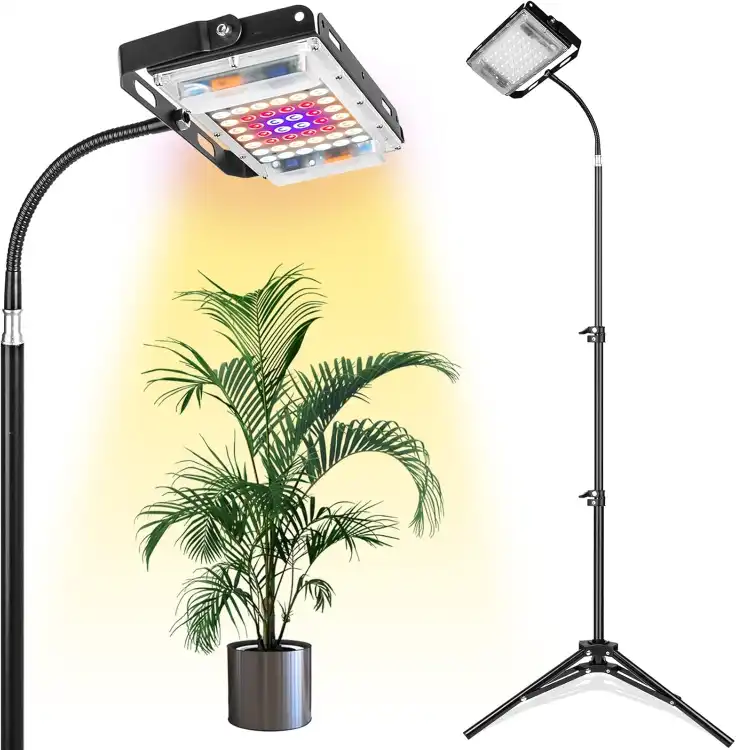
LBW Grow Light with Stand
Check on AmazonKey Specs
- Power: 30W (replaces 150W HPS or HID light)
- Adjustable Height: 15 inches to 48 inches
- Light Spectrum: Full spectrum (390nm-730nm), including White, Red & Blue
- Material: Aluminum base, painted finish
- Dimensions: 5.11″D x 5.31″W x 16.7″H
The LBW Grow Light with Stand is a versatile and efficient lighting solution for indoor gardening. Its adjustable tripod stand extends from 15 inches to 48 inches, making it suitable for a wide range of plants, from seedlings to large plants. The full spectrum LEDs, including red, blue, and white light (3500K & 6500K), provide optimal light for all growth stages. With its 30W power draw, it replaces a 150W HPS or HID light, saving on energy costs. The light is easy to install, and its gooseneck allows for customized positioning.
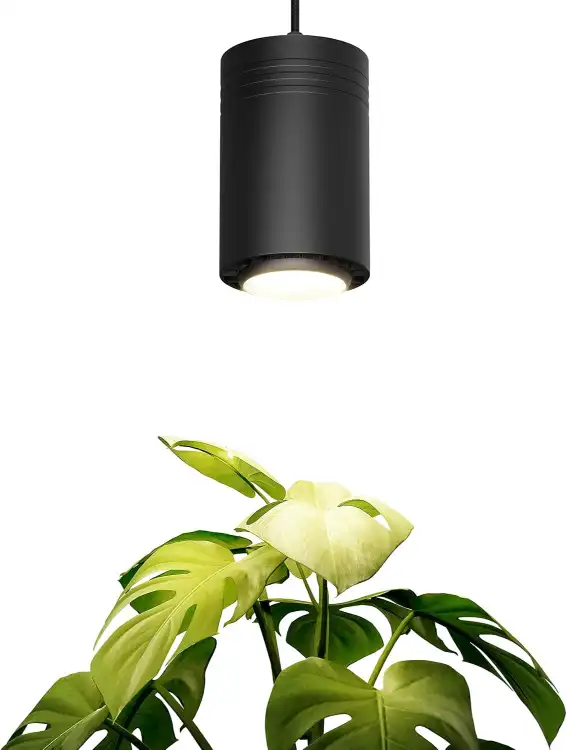
Aspect World’s First Decor Grow Light
Check on AmazonKey Specs:
- Material: Solid aluminum body
- Light Type: Warm white LED with sunset spectrum
- Installation: Quick setup with all hardware included
- Style: Modern, pendant fixture
- Designed: Hand-built in the USA for durability
The Aspect World’s First Decor Grow Light is a stunning blend of design and functionality. Featuring a signature warm white LED with sunset spectrum, it provides the perfect lighting for plant growth while enhancing your living space. Hand-built in the USA, its solid aluminum body ensures durability and elegance. This light allows you to place plants anywhere in your home, with no need to limit them to the window. Easy to install and aesthetically pleasing, the Aspect is designed to fit seamlessly into any room while providing the necessary lighting for healthy plants.
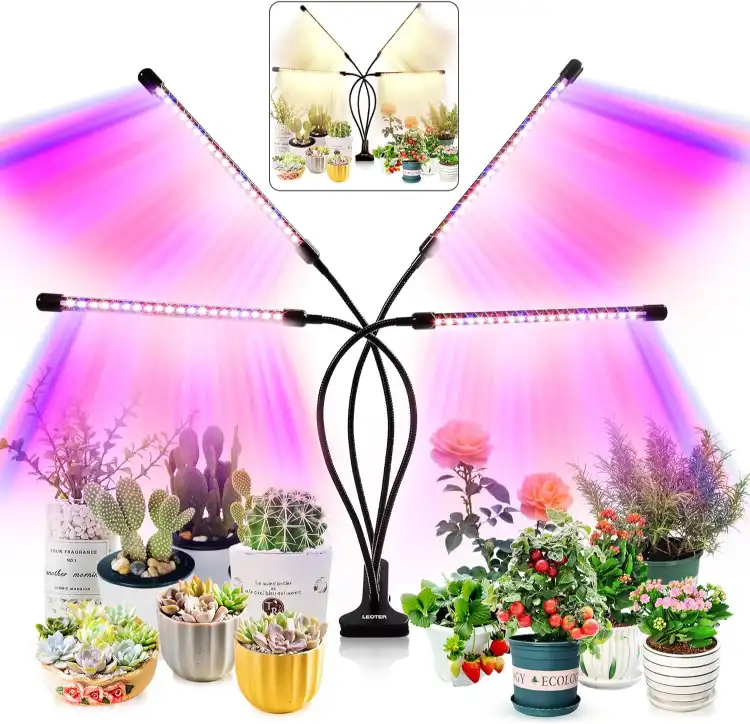
LEOTER Grow Light for Indoor Plants
Check on AmazonKey Specs:
- LED Combination: 80 LEDs (32 red, 12 blue, 36 full spectrum)
- Timer Function: Auto ON/OFF with 3, 9, and 12-hour settings
- Dimmable Modes: 10 light intensity levels with 3 spectral modes
- Adjustable Design: 360-degree flexible gooseneck
- Power Source: USB or AC power with included adapter
The LEOTER Grow Light for Indoor Plants offers a highly efficient and flexible solution for plant growth indoors. Featuring 80 LEDs (32 red, 12 blue, and 36 full spectrum), it ensures your plants get the light they need at various stages of growth. Its auto ON/OFF timer allows for easy, hands-free operation with preset times for different light spectrums. With 10 dimmable modes and a 360-degree flexible gooseneck, you can easily adjust the light intensity and position to suit your plants’ needs. The scientific heat dissipation design ensures the lamp stays cool, providing long-lasting, reliable performance for all types of plants.
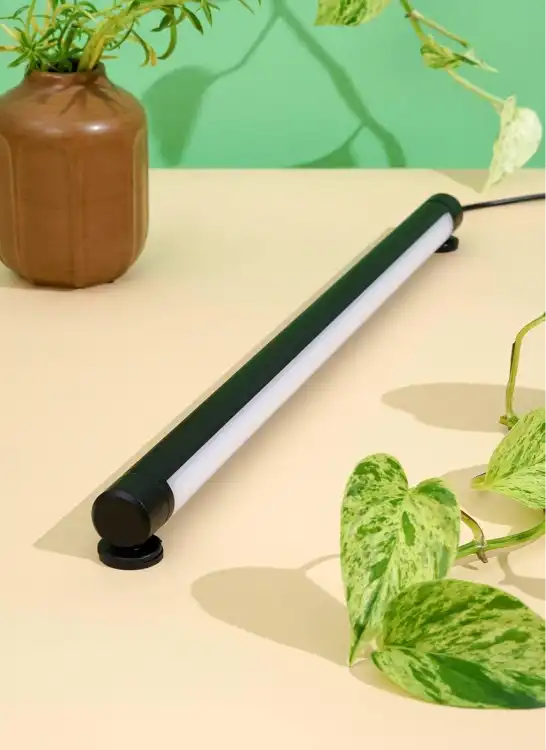
Soltech Solutions Grove™ LED Grow Light
Check on AmazonKey Specs:
- Mounting Options: Adhesive and screw installation
- Light Spectrum: Warm white LED, Sunset Spectrum
- Adjustability: 360° rotating magnetic bracket for easy positioning
- Control: Intuitive touch power and dimming control
- Design: Sleek, modern, and aesthetically pleasing matte finish
The Soltech Solutions Grove™ LED Grow Light is a top-tier solution for growing plants indoors while enhancing your living space. The intuitive touch control allows for easy adjustment of light intensity, providing the perfect ambiance for both your plants and your environment. It offers two installation options—adhesive for quick setup and screws for extra security—making it versatile and customizable. The sunset spectrum and warm white LED create a visually pleasing, natural light ideal for plant growth. Additionally, its 360° rotating magnetic bracket ensures precise lighting adjustments, offering optimal positioning for all stages of growth.
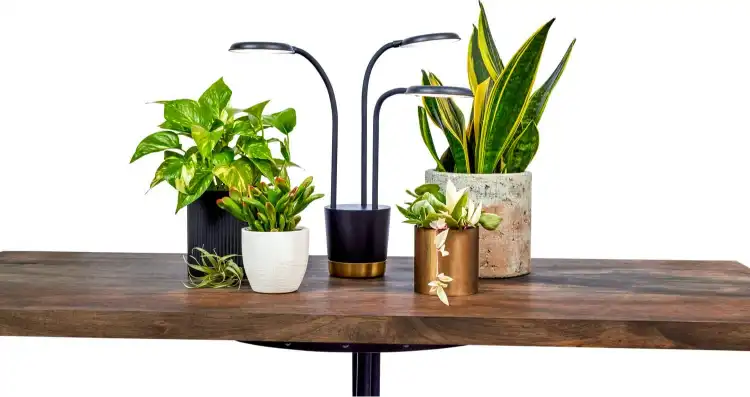
AeroGarden Trio Grow Light for Indoor Plants
Check on AmazonKey Specs:
- Light Type: Full-spectrum LED
- Design: Three adjustable arms, 5W LED per arm (15W total)
- App Integration: Customizable light schedule, dimming, and sunrise/sunset settings
- Adjustability: Suits plants up to 12 inches tall
- Power: Includes 6-foot power cord
The AeroGarden Trio Grow Light is an excellent solution for indoor plant enthusiasts, offering full-spectrum LED light that simulates sunlight, ensuring healthy plant growth year-round, even in the darkest corners of your home. The three-armed design provides optimal light coverage for multiple plants, and the adjustable arms accommodate plants up to 12 inches tall. With the AeroGarden app, you can easily customize your light settings, including a custom light schedule, dimming options, and sunrise/sunset features for a personalized plant care experience. The modern, functional design seamlessly blends with your space, offering both practical plant support and aesthetic value.
Understanding LED Grow Lights
LED grow lights are specialized devices that use light-emitting diodes to produce light for plant growth. Unlike traditional lighting systems, they can produce a specific spectrum of light that matches the absorption spectrum of plants, making them more efficient for plant growth.
The functionality of LED grow lights is based on the principle of electroluminescence. When an electric current passes through a semiconductor material in the LED, it causes the electrons in the material to move and emit light. The color of the light depends on the energy gap of the semiconductor, allowing LED grow lights to produce a wide range of light spectrums.
The science behind LED grow lights and plant growth lies in the photosynthetic active radiation (PAR), which refers to the light spectrum that plants use for photosynthesis. LED grow lights can be designed to produce light in the PAR range, ensuring that the light they produce is effectively used by plants for growth.
The Importance of Light for Plant Growth
Light plays a crucial role in the growth and development of plants. It is the primary energy source for photosynthesis, the process by which plants convert light energy into chemical energy to fuel their growth. Without sufficient light, plants cannot perform photosynthesis effectively, leading to stunted growth and reduced productivity.
Different light spectrums have different effects on plant growth. Blue light, for example, promotes vegetative growth by stimulating the production of chlorophyll, the pigment that absorbs light for photosynthesis. Red light, on the other hand, promotes flowering and fruiting by stimulating the production of phytochromes, the proteins that regulate plant growth.
By providing the right spectrum of light, LED grow lights can optimize the photosynthesis process and promote healthier plant growth. They can be tailored to the specific light needs of different plants, making them a versatile solution for indoor gardening and commercial growing operations.
Advantages of LED Grow Lights
LED grow lights offer several advantages over traditional lighting systems. One of the main benefits is their energy efficiency. LEDs are more efficient at converting electricity into light, meaning they produce more light per watt of electricity. This can result in significant energy savings, especially in large-scale growing operations.
Another advantage of LED grow lights is their long lifespan. LEDs can last up to 50,000 hours, significantly longer than traditional light bulbs. This reduces the need for frequent replacements, saving time and money in the long run.
Perhaps the most significant advantage of LED grow lights is their customizable light spectrum. Unlike traditional light bulbs, which produce a fixed spectrum of light, LED grow lights can be designed to produce a specific spectrum of light that matches the absorption spectrum of plants. This allows growers to tailor the light to the specific needs of their plants, promoting healthier growth and higher yields.
Different Types of LED Grow Lights
There are several types of LED grow lights available on the market, each with its own advantages and applications. Single color LED grow lights produce light in a single color or wavelength. They are typically used for specific stages of plant growth, such as vegetative growth or flowering.
Full spectrum LED grow lights produce light that covers the entire spectrum of visible light, similar to sunlight. They are designed to provide all the light spectrums needed for plant growth, making them a versatile solution for all stages of plant growth.
Adjustable spectrum LED grow lights offer the most flexibility. They allow growers to adjust the light spectrum to match the specific needs of their plants at different stages of growth. This can optimize the photosynthesis process and promote healthier plant growth.
Factors to Consider When Buying LED Grow Lights
When buying LED grow lights, there are several factors to consider. One of the most important is light intensity. Different plants require different light intensities for optimal growth. It’s important to choose a grow light that can provide the right intensity for your plants.
The light spectrum is another important factor. Different light spectrums have different effects on plant growth. It’s important to choose a grow light that can provide the right spectrum for your plants.
Size and coverage are also important considerations. The size of the grow light should match the size of your growing space. The coverage of the grow light should be sufficient to cover all your plants.
Finally, price and quality are important considerations. While it’s tempting to go for the cheapest option, it’s important to consider the quality of the grow light. A high-quality grow light may cost more upfront, but it can save you money in the long run by lasting longer and providing better results.
How to Choose the Right LED Grow Light for Your Plants
Choosing the right LED grow light for your plants requires a good understanding of your plant’s light needs. Different plants have different light requirements, depending on their species, stage of growth, and growing conditions. It’s important to research your plant’s light needs and choose a grow light that can meet those needs.
Matching the light spectrum to your plant’s needs is also crucial. Different light spectrums have different effects on plant growth. For example, blue light promotes vegetative growth, while red light promotes flowering and fruiting. It’s important to choose a grow light that can provide the right spectrum for your plant’s stage of growth.
Considering the size of your growing space is another important factor. The size of the grow light should match the size of your growing space. A grow light that is too small may not provide sufficient light for your plants, while a grow light that is too large may be overkill and waste energy.
Setting Up Your LED Grow Lights
Setting up your LED grow lights properly is crucial for achieving optimal results. The first step is to position the grow lights correctly. The lights should be positioned above the plants, at a distance that provides the right light intensity without overheating the plants.
Adjusting the light intensity and spectrum is another important step. The light intensity should be adjusted to match the light needs of your plants. The light spectrum should be adjusted to match the stage of growth of your plants. For example, you may need to increase the intensity and shift the spectrum towards red during the flowering stage.
Finally, it’s important to set up a lighting schedule that matches the natural day-night cycle. Most plants need a period of darkness to rest and prepare for the next day’s growth. A timer can be used to automate the lighting schedule and ensure consistent light conditions.
Maintaining Your LED Grow Lights
Maintaining your LED grow lights is crucial for ensuring their longevity and performance. Regular cleaning is one of the most important maintenance tasks. Dust and dirt can accumulate on the surface of the lights, reducing their light output and efficiency. It’s important to clean the lights regularly with a soft cloth to keep them working at their best.
Another important maintenance task is to monitor the performance of the lights. If you notice any decrease in light output or changes in the light color, it may be a sign that the lights need to be replaced. LED grow lights have a long lifespan, but they do wear out over time and need to be replaced.
Finally, it’s important to handle the lights with care. LED grow lights are delicate devices that can be damaged by rough handling. Always handle the lights with care and avoid dropping or hitting them.
Case Studies: Success Stories with LED Grow Lights
There are many success stories of indoor gardeners and commercial growers achieving great results with LED grow lights. One example is a hobbyist indoor gardener who was able to increase her tomato yield by 50% by switching to LED grow lights. The lights provided the optimal light spectrum for tomato growth and resulted in healthier plants and larger fruits.
On a larger scale, a commercial lettuce grower was able to double his production by switching to LED grow lights. The lights provided the right light intensity and spectrum for lettuce growth, resulting in faster growth and higher yields. The grower was also able to save on energy costs due to the efficiency of the LED lights.
These success stories highlight the potential of LED grow lights for improving plant growth and productivity. With the right setup and management, LED grow lights can help indoor gardeners and commercial growers achieve better results.
Potential Drawbacks of LED Grow Lights
While LED grow lights offer many benefits, they also have some potential drawbacks. One of the main drawbacks is their initial cost. LED grow lights are more expensive than traditional lighting systems. However, they can pay for themselves in the long run through energy savings and higher yields.
Another potential drawback is the risk of overheating. While LED lights produce less heat than traditional light bulbs, they can still generate heat, especially when used in large quantities. If not managed properly, this heat can damage the plants and reduce their growth.
Despite these potential drawbacks, many growers find that the benefits of LED grow lights outweigh the drawbacks. With proper management, the drawbacks can be minimized and the full potential of LED grow lights can be realized.
Overcoming Challenges with LED Grow Lights
There are several strategies for overcoming the challenges associated with LED grow lights. One of the main challenges is managing heat. While LED lights produce less heat than traditional light bulbs, they can still generate heat, especially when used in large quantities. To manage heat, it’s important to provide adequate ventilation and use heat sinks or fans if necessary.
Another challenge is maximizing cost-effectiveness. While LED grow lights are more expensive upfront, they can pay for themselves in the long run through energy savings and higher yields. To maximize cost-effectiveness, it’s important to choose a high-quality grow light that can provide the right light intensity and spectrum for your plants. It’s also important to manage the lights properly to ensure their longevity and performance.
With the right strategies, the challenges associated with LED grow lights can be overcome, allowing growers to reap the full benefits of this innovative technology.
Future Trends in LED Grow Lights
The field of LED grow lights is constantly evolving, with new technological advancements and trends emerging regularly. One of the main trends is the development of more efficient and powerful LEDs. These new LEDs can produce more light per watt of electricity, further improving the energy efficiency of LED grow lights.
Another trend is the increasing adoption of LED grow lights in commercial farming. As the benefits of LED grow lights become more widely recognized, more and more commercial growers are switching to this technology. This trend is expected to continue in the future, driving further advancements in LED grow light technology.
These trends highlight the exciting potential of LED grow lights for the future of indoor gardening and commercial farming. As the technology continues to evolve, we can expect to see even more improvements in plant growth and productivity.
Conclusion
Choosing the right LED grow light is crucial for achieving optimal plant growth and productivity. By understanding the role of light in plant growth and the benefits of LED grow lights, growers can make informed decisions and optimize their operations.
While LED grow lights have some potential drawbacks, such as their initial cost and the risk of overheating, these can be managed with the right strategies. With their energy efficiency, long lifespan, and customizable light spectrum, LED grow lights offer a sustainable and efficient solution for indoor gardening and commercial growing.
As the field of LED grow lights continues to evolve, we can expect to see even more improvements in plant growth and productivity. With the right setup and management, LED grow lights can help indoor gardeners and commercial growers achieve better results.
FAQ Section
What are LED grow lights?
LED grow lights are specialized devices that use light-emitting diodes to produce light for plant growth. They can produce a specific spectrum of light that matches the absorption spectrum of plants, making them more efficient for plant growth.
Why are LED grow lights beneficial for plant growth?
LED grow lights are beneficial for plant growth because they can provide the optimal light spectrum for photosynthesis, the process by which plants convert light energy into chemical energy to fuel their growth. They are also energy-efficient and have a long lifespan.
What are the potential drawbacks of LED grow lights?
The main drawbacks of LED grow lights are their initial cost and the risk of overheating. However, these drawbacks can be managed with the right strategies.
How do I choose the right LED grow light for my plants?
Choosing the right LED grow light for your plants requires understanding your plant’s light needs, matching the light spectrum to your plant’s needs, and considering the size of your growing space.
How do I set up and maintain my LED grow lights?
Setting up your LED grow lights involves positioning the lights correctly, adjusting the light intensity and spectrum, and setting up a lighting schedule. Maintaining your LED grow lights involves regular cleaning, monitoring the performance of the lights, and handling the lights with care.
